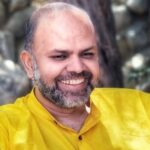Yogacharya Krishnamacharya once said that the mark of a healthy person is the ability to feel the nava rasas deeply and appropriately, and then return to shAntam the moment the context has passed. We explored this through techniques used in traditional theatre. This exploration threw up a lot of introspection in the group.
The group then proceeded to take up a few of the characters that they wanted to explore further. These explorations were done in the following manner: one of the participants announced that they would like to explore X character, others who wanted to join in volunteered. We ended up with 5 groups namely, duryOdhana, shakuni, dritarAshtra, karNa and arjuna. The group was supposed to enact a key scene, and the person who was the anchor took up other characters in the first two rounds of the enactment, and then became the character they chose. In the third round, the exploration of a new and different way of response was expected from the central character, and therefore from the others too as the new possibility developed.
Let us see what came of the duryOdhana exploration. The group wanted to explore the scene where duryOdhana comes to the palace of illusions, wets his dhoti and is laughed at by draupadi. What was extraordinary to start with was that three of the six that formed the group were women and the anchor was a woman! What a courageous step to take, to say let me get into the skin of an archetype that torments women!
The central exploration was around the impossibility of duryOdhana to take a joke. Here is a very talented and powerful young man who is so caught up with his narcissism and child mind that he cannot bear to be found making a mistake. “I must be seen and appreciated in the way I want to be, and in no other way!” he screams. “I cannot be seen as small and inadequate, if I am I will be so vindictive that I will plot your humiliation.” “This or nothing, all or none, now or never” the discourse of a five year old narcissus believing that he is the king of all he surveys. The hurt of being seen as a fool by the woman he most admires. The power of envy came through- “they possess that which is the most desirable” and compounded by narcissism, this becomes a reminder of one’s own lack of worth. A new alternative, one where duryOdhana could laugh at himself, simply did not take off!!
The women found immense release in seeing how small and wounded the psyche of duryOdhana was. The men confronted the prison that duryOdhana lives in when he is constantly seeking affirmation of his worth.
At the end of the enactment the whole group reflected upon and voiced the duryOdhana, draupadi and karNa (the main protoganists). The innocence and playfulness of draupadhi surprised by the vehemence of the insult felt by duryOdhana, karNa’s proxyhood and blind empathy with his friend, and the depth of hurts that each of us carry from our early childhood came through clearly. The totally unrealistic conceptions of self and the world that a child has as he/ she awakens to their own self conscious existence became clear. This is the root of Avidya. Hurt to our own construct of our selves is inevitable, and as a part of that, the let down of the world (that we have imagined) is also inevitable. However, a large part of our victim selves carries these hurts, hugs them close and makes a promise never to be hurt again! The rest of one’s life is a mortgage to this promise. Any act of vengefulness that is triggered by this mortgage is seen as a just recompense.
How extraordinarily wasteful of ones own life and how we hold others around us hostage to our victimhood! Many family feuds and community antagonism seem like reflections of the duryOdhana child mind. India Vs Pakistan? Immature patriotism? Ill-conceived nationalism?

 Anoop is a student of Yoga, an entrepreneur, a coach and a father of two young boys. He has led successful leadership stints in both the corporate and non-for-profit sectors. On encountering the country’s water/farmer crises at close quarters, he decided to pause and examine the impact various ‘isms’ – capitalism, colonialism, etc., were having on us as individuals, families, the society and the environment at large. This quest led him to formally engage with traditional Indic knowledge systems while also learning from the latest advances in science – about our physical and mental wellbeing, importance of body and mind work in healing trauma and the urgent need for a conscious rebuilding of family / work / social structures if we have to thrive individually and collectively. Insights, frameworks and processes gleaned from these on-going studies, an anchorage in his own personal practice and his wide-ranging experiences is what Anoop brings to facilitation/coaching spaces in Ritambhara and his various professional engagements.
Anoop is a student of Yoga, an entrepreneur, a coach and a father of two young boys. He has led successful leadership stints in both the corporate and non-for-profit sectors. On encountering the country’s water/farmer crises at close quarters, he decided to pause and examine the impact various ‘isms’ – capitalism, colonialism, etc., were having on us as individuals, families, the society and the environment at large. This quest led him to formally engage with traditional Indic knowledge systems while also learning from the latest advances in science – about our physical and mental wellbeing, importance of body and mind work in healing trauma and the urgent need for a conscious rebuilding of family / work / social structures if we have to thrive individually and collectively. Insights, frameworks and processes gleaned from these on-going studies, an anchorage in his own personal practice and his wide-ranging experiences is what Anoop brings to facilitation/coaching spaces in Ritambhara and his various professional engagements.
 Priya is a Yoga therapist in the Krishnamacharya tradition. She adapts Reiki & energy work, Vedic chanting, life coaching & Ayurvedic practices in her healing spaces. She is committed to nurturing collectives that have the praxis of Yoga at their heart.
Priya is a Yoga therapist in the Krishnamacharya tradition. She adapts Reiki & energy work, Vedic chanting, life coaching & Ayurvedic practices in her healing spaces. She is committed to nurturing collectives that have the praxis of Yoga at their heart. Anisha has been on an exploration to understand herself through yoga for the last 15years which led her to teaching yoga, yoga therapy and inner work through yoga.
Anisha has been on an exploration to understand herself through yoga for the last 15years which led her to teaching yoga, yoga therapy and inner work through yoga. Apoorva chanced upon Yoga in her early 20s. A spark was lit within and there was no turning back. Her exploration led her to the Krishnamacharya tradition more than a decade ago. Curious about human behaviour and what drives it, she was thrilled when her search ended (and also began) when she first came upon the Yoga Sutra, which illuminated a path towards answering many questions that had been held for a long time.
Apoorva chanced upon Yoga in her early 20s. A spark was lit within and there was no turning back. Her exploration led her to the Krishnamacharya tradition more than a decade ago. Curious about human behaviour and what drives it, she was thrilled when her search ended (and also began) when she first came upon the Yoga Sutra, which illuminated a path towards answering many questions that had been held for a long time. Anita is a yoga teacher and therapist in the tradition of Sri.T.Krishnamacarya and Sri T.K.V. Desikachar, a Reiki practitioner and a Life Coach. She is also the founder of Vishoka, a center for learning Indic and energy-based frameworks for living and healing. Her deep concern for human suffering and the problems of unsustainable living kept her on the path of seeking an integrated approach to looking at life, living, learning and healing.
Anita is a yoga teacher and therapist in the tradition of Sri.T.Krishnamacarya and Sri T.K.V. Desikachar, a Reiki practitioner and a Life Coach. She is also the founder of Vishoka, a center for learning Indic and energy-based frameworks for living and healing. Her deep concern for human suffering and the problems of unsustainable living kept her on the path of seeking an integrated approach to looking at life, living, learning and healing. Ankit is a seeker in the wisdom traditions of India. The core of his work includes creating dialogic spaces where people can look within and see the connection between their inner and outer lives. Inspired by the likes of Gandhi, Aurobindo, Vivekananda and Guru Gobind his experiments in service took him back to his roots in Punjab where he is creating a community-led model of higher education which is open, inclusive and accessible for all. Ritambhara for him is a space for engaging in a community which is committed to a DHramic life. He anchors his work of learning and leadership in the Antaranga Yoga Sadhana and the humanistic wisdom of Mahabharata.
Ankit is a seeker in the wisdom traditions of India. The core of his work includes creating dialogic spaces where people can look within and see the connection between their inner and outer lives. Inspired by the likes of Gandhi, Aurobindo, Vivekananda and Guru Gobind his experiments in service took him back to his roots in Punjab where he is creating a community-led model of higher education which is open, inclusive and accessible for all. Ritambhara for him is a space for engaging in a community which is committed to a DHramic life. He anchors his work of learning and leadership in the Antaranga Yoga Sadhana and the humanistic wisdom of Mahabharata.